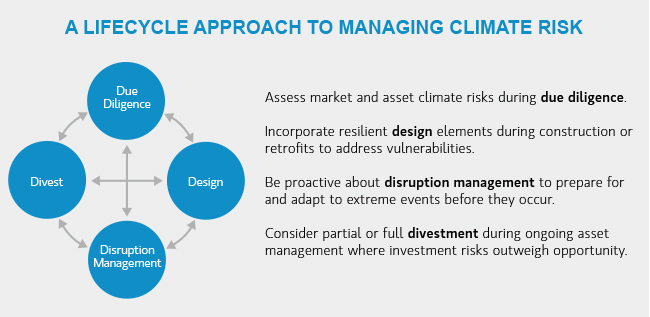Climate change poses growing challenges for investors in real assets. What’s the key to building resilience into real estate, infrastructure and other real-asset investments?
As hurricanes, droughts and other severe weather events grow more frequent and destructive, investors who own real assets—such as buildings, airports, pipelines and cell towers—need to take stock of how resilient their portfolios are. That is, how much has been done to plan for adverse events and how ready are all stakeholders to respond and recover?
Building up resilience involves taking a lifecycle approach to managing such investments: preparing for big weather-related disruptions, handling them deftly when they happen, and working with insurers, local authorities and others along the way. A recent report from Morgan Stanley 's Real Assets Investing Team and the firm’s Institute for Sustainable Investing, “Weathering the Storm: Integrating Climate Resilience into Real Assets Investing,” lays out the steps that investors should take to apply a “climate lens” to their properties.
Given that real assets are often held for 10 years or more, “climate resilience is becoming an investment imperative,” says John Klopp, Head of Global Real Assets at Morgan Stanley Investment Management. “By undergoing a comprehensive evaluation of climate change impacts at the asset level, investors can most accurately weigh risks and returns.”
Investors should thoughtfully consider climate risk at all stages of an investment.
The Scope of the Problem
As weather and other climate-related disasters intensify globally, so do the economic effects. According to the U.S. National Oceanic and Atmospheric Administration, the number of inflation-adjusted, billion-dollar climate disaster events in the U.S. alone grew from 28 during the 1980s to 91 from 2010 to 2017. And the average annual costs rose from $16.7 billion in the 1980s to $80.5 billion from 2010 to 2017.*
Many coastal cities around the world that look attractive to real assets investors—for example, Miami, New York, Boston, Osaka, Guangzhou and Mumbai—are particularly vulnerable to flooding and other weather-related problems. And infrastructure assets favored by investors, like airports, cell towers and oil and natural gas pipelines, are often located in places prone to storms and extreme heat, the report noted.
Insurance will continue to be an important safeguard, but a limited one. “With climate change posing new and ever greater economic risks, old business models will no longer suffice,” says Hilary Irby, Head of Global Sustainable Finance for Morgan Stanley. “As with other industries, insurance models will need to assess risk in a changing climate, and investors can work with insurers to find win-win solutions.”
The Lifecycle Approach
Beyond buying insurance, real assets investors can take many steps to help control risks and contribute to profitability throughout an investment’s lifecycle. Potential pay-offs include lower operating costs, averted damage, rising property values and revenue growth from higher occupancy rates.

A step-by-step approach to managing risks begins with due diligence, which involves evaluating climate threats facing a market and asset, then assessing the ability and costs to enable the asset to withstand those risks.
Investors should look at design improvements that can boost resilience and consider the costs to retrofit assets to higher standards. Could the property benefit from storm-resistant windows, extra insulation or backup generators? If it sits in an area prone to hurricanes, are the electrical and telecommunications systems out of reach of potential floodwaters? Do telecommunications networks have backup data centers and alternative hardware to support continuity of operations?
At the same time, investors must set up a plan to manage disruptions if disaster does strike. This means lining up suppliers and contractors who will be ready to respond in an emergency, ensuring business continuity plans are in place.
But these efforts to protect a real asset can only go so far. Investors should continuously evaluate whether an assets returns outweigh associated risks and make an informed hold/sell assessment.
Given the speed at which climate hazards seem to be accelerating, “investors should thoughtfully consider climate risk at all stages of an investment,” notes Josh Myerberg, a Managing Director in the Real Assets group of Morgan Stanley Investment Management. “They should continually be making decisions about design, disruption management and divestment. Doing so will enable them to build and manage a resilient portfolio for the long term.”
With climate change posing new and ever greater economic risks, old business models will no longer suffice.
Miami: Resilience in Action
One example of this resilience planning process comes from Lincoln Road in Miami’s South Beach neighborhood, a thriving shopping and dining destination where hurricanes, flooding and other weather-related problems are routine.
After a due-diligence review determined that the benefits of owning and operating buildings in South Beach outweighed the risks, ownership set out to build climate resilience into all phases of its management plan. The properties’ robust design features include heavy-storm-resistant windows and above-ground mechanical equipment secured against flood damage. The emergency response plans, stored onsite and offsite, include pre-arranged contracts with suppliers to protect and repair the property in the event of a storm.
While the buildings may be vulnerable to threats like hurricanes and rising sea levels, careful planning across the investment lifecycle has enabled ownership to make an in-depth assessment of climate risks, establish a resilience strategy and help protect the site against physical and safety risks in the event of an emergency.
*National Oceanic and Atmospheric Administration, “Assessing the U.S. Climate in 2017,” (2018); accessed Feb. 22, 2018



